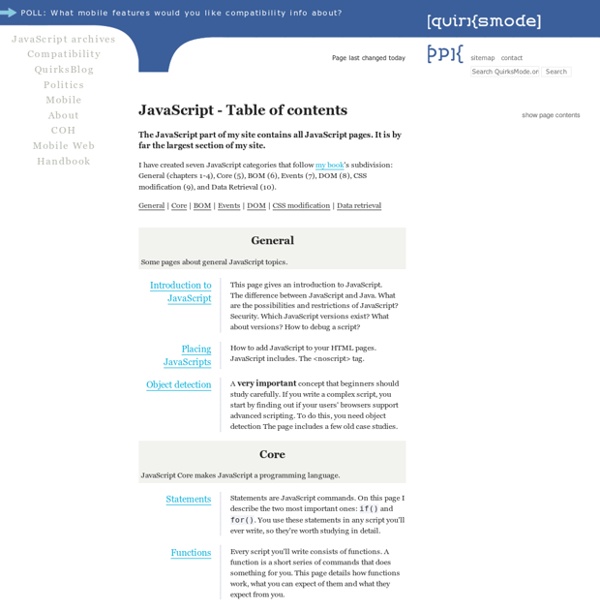



jQuery Fundamentals :: JavaScript Basics jQuery is built on top of JavaScript, a rich and expressive language in its own right. This section covers the basic concepts of JavaScript, as well as some frequent pitfalls for people who have not used JavaScript before. While it will be of particular value to people with no programming experience, even people who have used other programming languages may benefit from learning about some of the peculiarities of JavaScript. Here's a simple JavaScript program that adds a message to the page: In the above example, we use a function called log. You can try running this program by clicking the and it will copy the code to the built-in editor automatically. It's OK if you don't understand everything that's going on in this program; in the rest of this section, we'll talk about variables, functions, and several other building blocks of JavaScript. A comment about comments Comments can be a useful tool for explaining what's happening in a piece of code. The building blocks of JavaScript Objects
Leaflet - a modern, lightweight JavaScript library for interactive maps by CloudMade YUI Theater: Douglas Crockford, The JavaScript Programming Language I’ve shared on YUIBlog and in the YUI Theater two presentations created by Yahoo! JavaScript Architect Douglas Crockford (“Advanced JavaScript” and“An Inconvenient API: The Theory of the Dom”). Today I’m happy to announce that Douglas’s more foundational talk “The JavaScript Programming Language,” is publicly available. In this presentation, which is meant to be the beginning of the three-course sequence (followed by “Theory of the DOM” and then “Advanced JavaScript”), Douglas explores not only the language as it is today but also how the language came to be the way it is. It’s always worth pointing out that ideas and perspectives are Douglas’s own and that the many eggregious flaws in videographic craftsmanship are mine. Download slides (zipped PowerPoint file)
Tout JavaScript La référence javascript Tout JavaScript.com vous propose sur cette interface ergonomique et conviviale, plus de 230 fiches détaillant précisément les objets javascript , leurs propriétés et leurs méthodes . , les fonctions natives et les mots de structures sont regroupés dans le répertoire Mots_clefs. Naviguez simplement dans l'arborescence des objets dans le menu de gauche. Quand vous lancez une fiche, l'arborescence du menu s'ouvre à la position de l'objet sélectionné. Cette référence javascript, développée et écrite pour Tout JavaScript.com, est en constante évolution. Erreur ?] Accès rapide : window, document, Array, RegExp, Math, Image, navigator...
Dojo: The Definitive Guide Copyright © 2008 Matthew A. Russell O'Reilly books may be purchased for educational, business, or sales promotional use. Online editions are also available for most titles (safari.oreilly.com). For more information, contact our corporate/institutional sales department: (800) 998-9938 or <corporate@oreilly.com>. Nutshell Handbook, the Nutshell Handbook logo, and the O'Reilly logo are registered trademarks of O'Reilly Media, Inc. Java™ is a trademark of Sun Microsystems, Inc. Many of the designations used by manufacturers and sellers to distinguish their products are claimed as trademarks. While every precaution has been taken in the preparation of this book, the publisher and author assume no responsibility for errors or omissions, or for damages resulting from the use of the information contained herein.
The Node Beginner Book Intro Javascript--what the heck is it? Is it a really difficult programming language that casual web designers should be afraid of? What is it used for? JavaScript has been around for several years now, in many different flavors. By definition, JavaScript is a client-side scripting language. There are many uses (and abuses!) Clocks Mouse Trailers (an animation that follows your mouse when you surf a site) Drop Down Menus Alert Messages Popup Windows HTML Form Data Validation Before you begin this tutorial, you should have basic knowledge of HTML. This tutorial will cover the basics of JavaScript, from where to place your JavaScript all the way to making your own JavaScript functions. We recommend that you read a few lessons a day and practice what you have learned. Report a Bug or Comment on This Lesson - Your input is what keeps Tizag improving with time!
JavaScript Date Format Saturday, June 9th, 2007 • Related • Filed Under Update: The documentation below has been updated for the new Date Format 1.2. Get it now! Although JavaScript provides a bunch of methods for getting and setting parts of a date object, it lacks a simple way to format dates and times according to a user-specified mask. When choosing which special mask characters to use for my JavaScript date formatter, I looked at PHP's date function and ColdFusion's discrete dateFormat and timeFormat functions. With my date formatter, I've tried to take the best features from both, and add some sugar of my own. Before getting into further details, here are some examples of how this script can be used: var now = new Date(); now.format("m/dd/yy"); dateFormat(now, "dddd, mmmm dS, yyyy, h:MM:ss TT"); now.format("isoDateTime"); dateFormat.masks.hammerTime = 'HH:MM! Following are the special characters supported. And here are the named masks provided by default (you can easily change these or add your own):